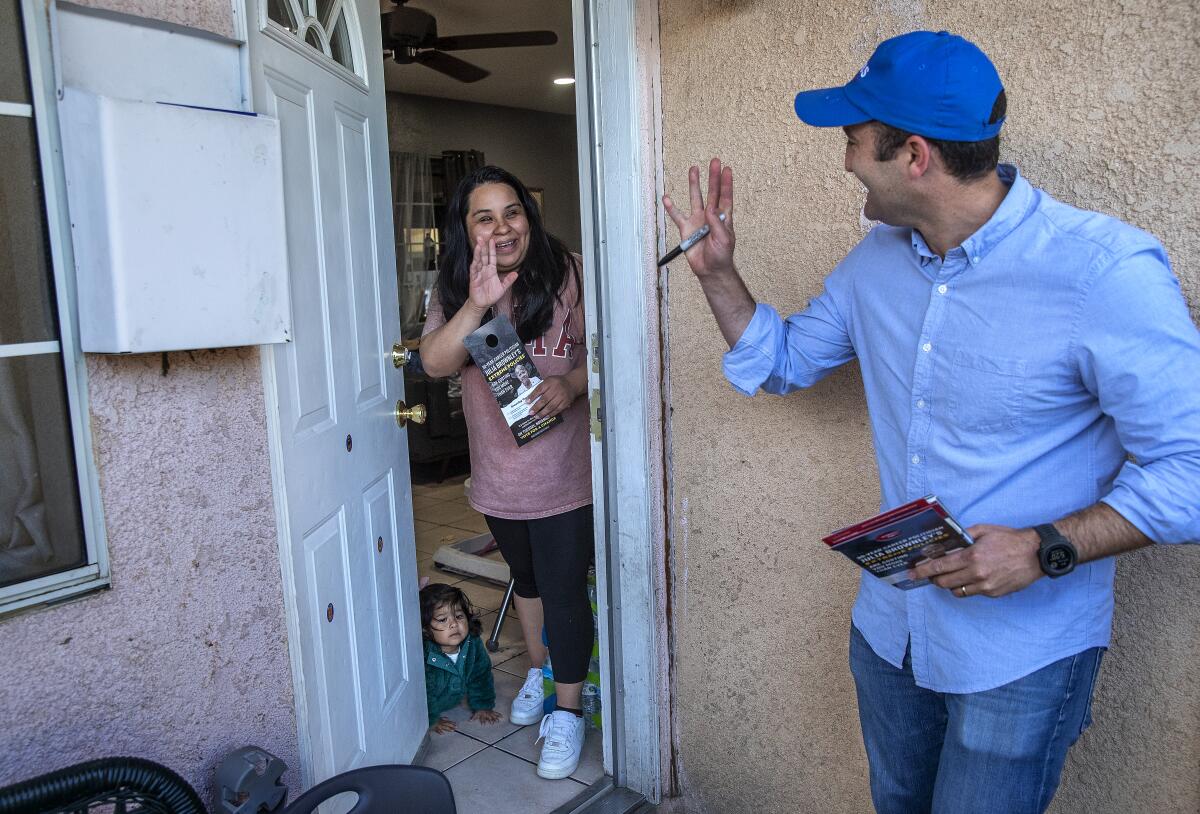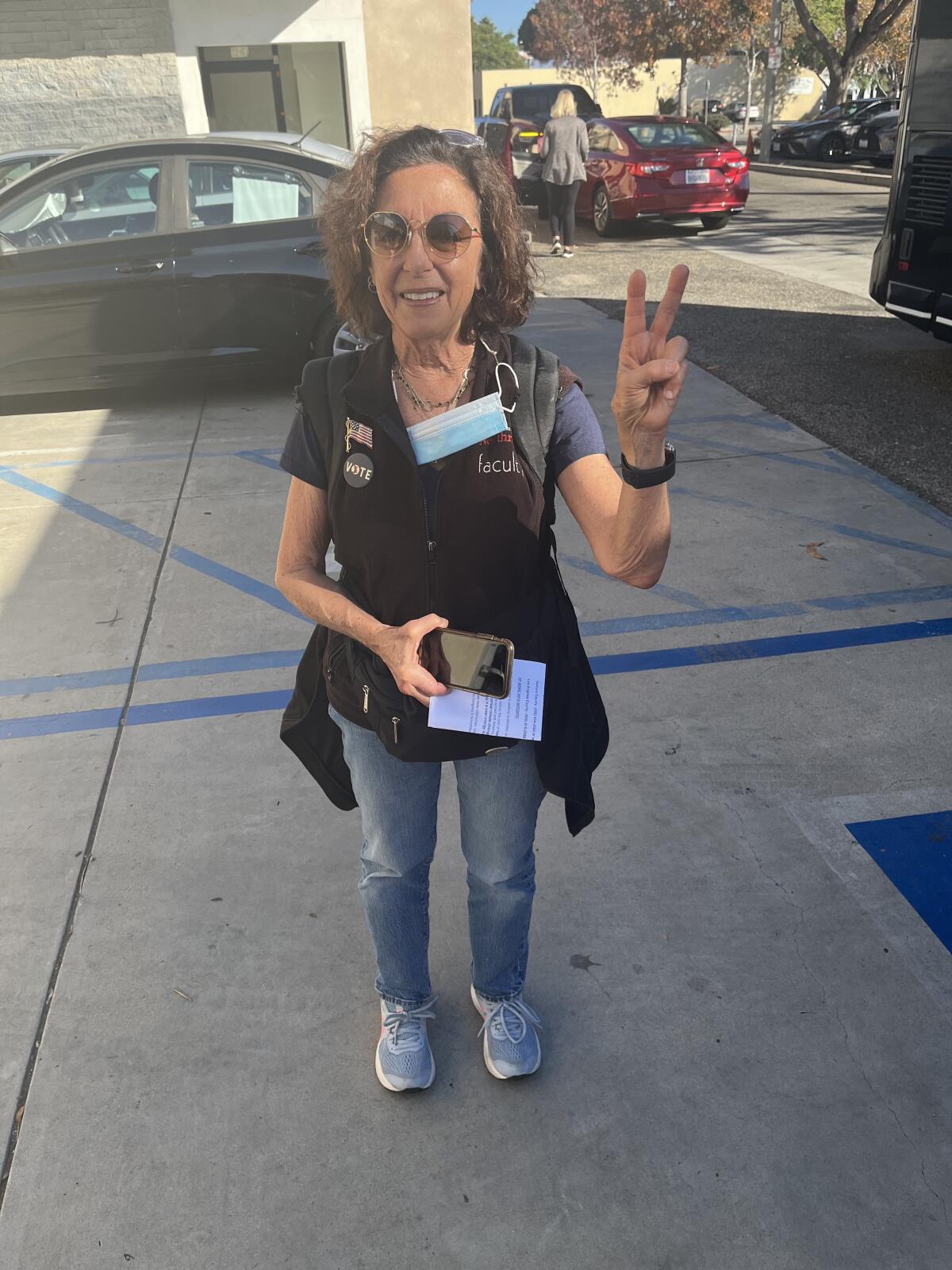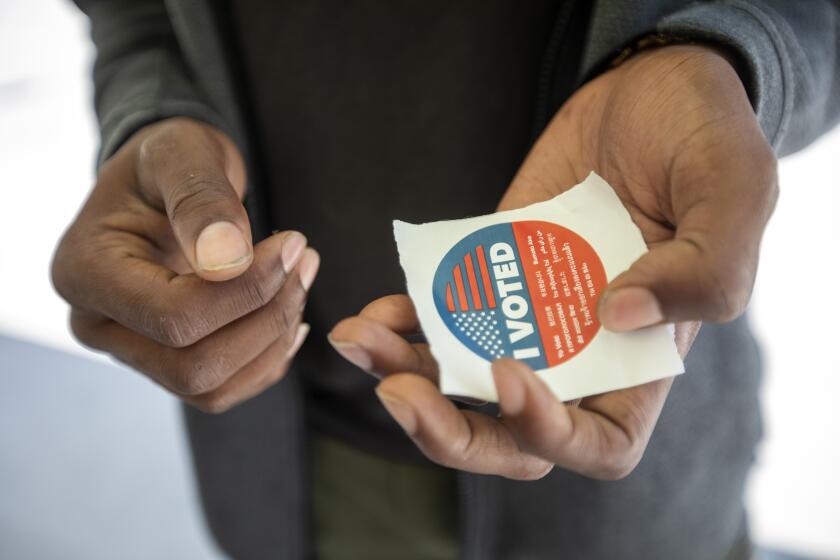These California districts voted big for Biden, but Republicans are optimistic about their chances

As the sun set behind rows of modest homes, Republican Matt Jacobs knocked on doors urging voters in Oxnard to ditch their incumbent Democratic congresswoman and pick him to improve their quality of life.
“I care deeply about this community,” Jacobs told Jacqueline Mercado, 28, adding that he was born and raised in Ventura County, a message he repeated in English and fluent Spanish in this predominantly Latino neighborhood. “I just think things can be better all around.”
With her 1-year-old daughter crawling nearby, Mercado, a Democrat, nodded vigorously when Jacobs asked if the cost of groceries was affecting her family. “Absolutely,” Mercado said, before telling him that she would vote for him in Tuesday’s election.
“I just want someone to make everything better,” said Mercado, an employee of the state’s toll-free 211 system that connects Californians with job training, after-school programs and other services. “Make things better, like inflation. That really matters, because gas is crazy right now. Food. Everything.”

Such pocketbook concerns are among the reasons Republicans say they feel good about their odds in blue regions like California’s 26th Congressional District, which Joe Biden won by 20 points.
The GOP is favored to take control of the House in Tuesday’s election, and voters like Mercado could make that happen or determine the size of its majority.
The midterms have been defined by Republicans arguing that Democrats are poor stewards of the economy and their policies have fomented rising crime and Democrats warning that Republicans are too extreme when it comes to abortion rights, threats to democracy and potential cuts to Social Security.
The 26th, largely based in Ventura County with a sliver of Los Angeles County, is probably a reach for Republicans. But the prospect of it being in play suggests vulnerability for Democrats in a number of districts in California and across the country that Biden won by double digits.
“If California Democrats have a headache in California 26, they’ve got the flu in a whole range of more competitive seats,” including contests in the Central Valley and Southern California, said David Wasserman, a congressional forecaster for the nonpartisan Cook Political Report.
In the November midterm election, California is one of the battlefields as Democrats and Republicans fight over control of Congress.
Democrat Julia Brownley has represented much of Ventura County in Congress since 2013. On Tuesday, the district was moved from “solid Democrat” to “lean Democrat” by Cook, which based its prognostication on a poll that showed a statistical dead heat between the candidates and the amount of money flowing in.
The Cook Report also forecast tightening contests in districts represented by Democrats Katie Porter of Irvine and Josh Harder of Turlock.
Many of these districts, in historically conservative bastions such as Porter’s in Orange County, are now closely split between Democratic and Republican voters, or are places where Democrats wield a numeric edge but have a Republican incumbent, such as Reps. Mike Garcia of Santa Clarita and David Valadao of Hanford.
The 26th District, however, doesn’t fit into either of these categories. The incumbent is a Democrat, and though the district gained conservative Simi Valley in the 2021 redrawing of congressional maps, Democrats still have a nearly 15-percentage-point voter registration edge.
Wasserman was among the prognosticators who was skeptical when Brownley’s prospects were initially questioned.
“But clearly the environment has deteriorated for Democrats since then,” he said. “Though she’s still a clear favorite, she is not in as solid shape because Republicans have a credible candidate and there is still some ancestral Republican support in Ventura County.”
Inflation, gas prices, concerns about crime and the lack of exciting statewide campaigns are a boon for Republicans, said Democratic strategist Andrew Acosta.
“All of this is a toxic brew,” he said, adding that voters in districts like Brownley’s may be liberal on social issues but malleable on economic matters. “And we are in a pocketbook election.”
Call it the ‘I don’t know’ election in the fight for Congress. Republicans still have advantages, but Democrats appear energized in the post-Roe environment.
GOP politicians represented the area in Congress for 70 years, until Brownley won her seat in 2012. One out of five of the district’s voters decline to identify with a political party.
More than 20 House campaign committees and leadership PACs contributed to Brownley and Jacobs over a three-day span in late October, making it “the top House target for Republicans and Democrats alike” for such efforts, according to the research director for the California Target Book, a nonpartisan guide that analyzes races in the state. A pro-Brownley outside group recently chipped in a half-million dollars.
GOP redistricting expert Matt Rexroad said that these moves, as well as President Biden’s appearance with Rep. Mike Levin in Oceanside on Thursday, indicate that several districts in California are competitive.
“Follow the money,” he said. “The fact that President Biden is coming to northern San Diego and the fact you have money moving to Brownley means that something is in play.”
Brownley concedes that “this is a tough election.”
“It’s tightening up all around the country,” she told scores of volunteers on a recent chilly morning in an Oxnard parking lot. After posing for pictures with the congresswoman, they were bused to Calabasas and Agoura Hills to knock on doors.
Brownley said she is optimistic about her prospects because of her relationship with her constituents as well as voters’ stances on abortion, the environment and immigration.
“I never give up hope,” she said in an interview. “My values and the district’s values are aligned.”
California midterm election: Rep. Julia Brownley and Matt Jacobs’ House race is key to the balance of Republican or Democratic power in Congress.
Both candidates portray themselves as moderates, but they are clearly in sync with their respective party’s base.
Jacobs, a former federal prosecutor who twice voted for President Trump, said the Supreme Court ruling that ended federal abortion rights was constitutionally correct, but said he would not vote for a federal abortion ban. Though he said he supports abortion access in cases of rape, incest and health of the pregnant woman, Jacobs would not say whether he supported broader abortion rights.
Brownley paints Jacobs as an extremist supported by Republicans who back a nationwide ban, and says California voters care about abortion rights beyond the state’s borders.
“Women in California are smarter than that, and they’re in the fight for every single woman across the country, not just for women here,” Brownley said.
This message is personal for Terri Lisagor, a retired professor who lives in Camarillo. When she was in college, her roommate became pregnant and traveled to Mexico for an abortion.

Lisagor, 73, acknowledged that she was concerned about Democratic prospects this election.
“We get complacent — ‘Oh, sure, California is so blue, it won’t matter,’” she said, shortly before canvassing for Brownley in Calabasas. “We need to keep harping on it, keep encouraging people to vote.”
Here’s how to vote in the California midterm election, how to register, what to do if you didn’t get mail ballot or if you made a mistake on your ballot.
Republicans have homed in on similar congressional districts that supported Biden in states that include Oregon, Connecticut, Rhode Island and New York.
The Congressional Leadership Fund, a well-funded super PAC aligned with House Republican leader Kevin McCarthy of Bakersfield, has targeted 11 districts that Biden won by double digits. Five are in California, including the 13th District in the Central Valley.
The 13th District is a rare open seat that’s contested by Democratic Assemblyman Adam Gray and Republican businessman John Duarte. Democrats have a 14-point voter edge over Republicans in the heavily agricultural district; Biden underperformed there, winning by 11 points.
The district is one of five rated as toss-ups in California; six others are viewed as in play.
Democratic strategists express concern about some of these districts, but are skeptical about how competitive Brownley’s is.
Darry Sragow, a Democratic strategist and publisher of the Target Book, described the intensified focus on the contest as either Republicans trying to make Democrats spend money on the race, or having research that suggests it’s closer than it appears.
“Most of the time, in a race like this, the numbers hold and Brownley would hold the seat,” he said. “But every once in a while, a challenger shows up with a recipe for the special sauce and pulls off an upset.”
More to Read
Get the L.A. Times Politics newsletter
Deeply reported insights into legislation, politics and policy from Sacramento, Washington and beyond. In your inbox three times per week.
You may occasionally receive promotional content from the Los Angeles Times.















